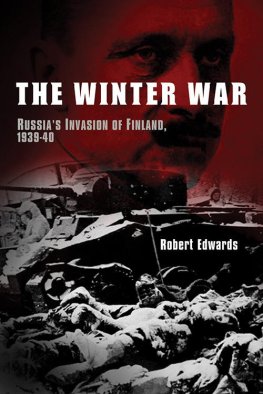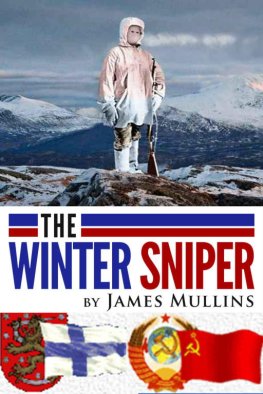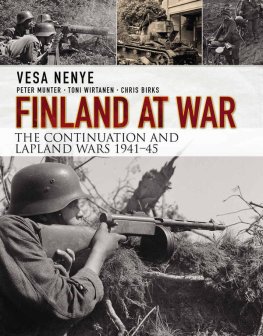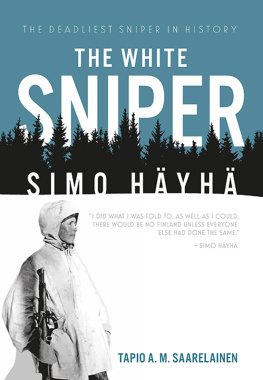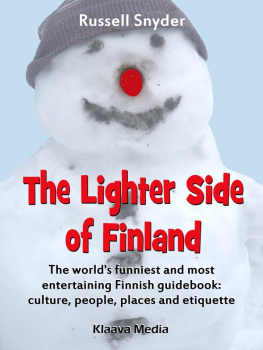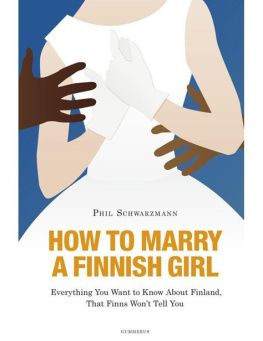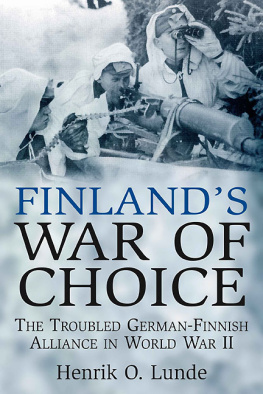
THE WINTER WAR:
Russias Invasion of Finland, 1939-1940
Robert Edwards
List of Maps
Stalins attack on Finland
Intended assault on the Isthmus
The battle for SuomussalmiRaate
The defeat of the 44th Division
The battle for Tolvajrvi
The advance to the Aittojoki River
Finnish counter-attack, 23 December
Plans for Allied relief efforts on Finland
The Red Armys advance into LadogaKarelia
The Red Army advance to Viipuri
The Finnish border adjustments, March 1940
List of Photographs
Mannerheim as Chairman of the Defence Council, 1937.
King Gustav of Sweden (left), Erkko and President Kallio at the Stockholm Conference, 1939 (IWM).
Vin Tanner, Paasikivi and Baron Yrj Koskinen depart for Moscow, October 1939 (IWM).
A Lotta unit preparing food at a Finnish reservist camp, October 1939 (IWM).
A passenger bus takes a direct hit, Helsinki, December 1939 (Photo Pressens Bild, Stockholm).
A Red Baltic Fleet bomber, one of many downed over the Isthmus. It would be recycled very soon (IWM).
Life on the Mannerheim Line (IWM).
Morning prayers (IWM).
The northern front at Salla, where Wallenius had, early in the war, distinguished himself (IWM).
The terrain at Tolvajrvi.
The monochrome landscape of the Winter War.
A Finnish machine-gun crew on the Karelian Isthmus, January 1940 (IWM).
A Finnish mobile kitchen (IWM).
A column of Red Army POWs after Suomussalmi, January 1940 (IWM).
Two Finns walk past some of the remnants of the Red Armys 44th Division after retaking the field. Suomussalmi, January 1940 (IWM).
Karelian refugees prepare to leave their homes, March 1940 (IWM).
Preface
FOR ANY STUDENT OF international relations, let alone those purely military matters that arise from them, the history of Finland is of unique importance in the general European context, let alone the narrower Nordic one. This book examines the short, savage war that erupted between the Soviet Union and Finland in late 1939the Winter War.
Counter-factual history is an amusing parlour game, but seldom anything more. To speculate upon the great what-ifs of the past is generally a fruitless or frustrating exercise, but the first question that naturally arises when surveying the course and outcome of the Winter War is one of particularly high impact. Had this unique conflict led to a different outcome, would Operation Barbarossa have even been possible? For once, perhaps, that question is worth asking. Certainly, Soviet policy with regard to Finland was intended to forestall such an event as Barbarossa and as such it clearly failedbut why? How on earth did the largest force ever assembled, with total numerical and technical superiority in every arm, manage not to annihilate one of the smallest?
My own interest in this subject goes back to the 1970s, when, as an undergraduate reading International Politics, I found myself studying the Russian foreign policy of forward defence and, not unnaturally, the role played by Finland in defining (and serially frustrating) that policy. The price it paid for doing so emerged rapidly, if not necessarily very clearly. This is partly due to the fragmented nature of published documents, given the unique nature of Russo-Finnish relations, which very often functioned at a highly personal level. Although there was little love lost between the two cultures as a whole, there is ample evidence that the ebb and flow of actual relationships played an extraordinary function in the broader bilateral one. The tangled but very intimate nature of these matters even gave rise, post-1945, to a new wordFinlandization, more or less defined as the attempt to exercise control over the internal affairs of a neighbouring nation-state without actually possessing its territory or even colonizing it.
The present work is an attempt to account for the necessity of such a policy, and to explain how it came into beingto examine the attempt made by the Soviet Union on the last day of November 1939 to effectively annexe the territory of Finland by invasion, why they failed, and to introduce the reader to some of the consequences.
This is a complex European storythe United States plays only a marginal (and less than triumphant) role in it. The painfully convoluted development of Anglo-French relations with both the Soviet Union and greater Scandinavia are basic to it, but at the core of the story is that uniquely tough body of people, the Finnish nation.
Robert Edwards
SOMERSET, 2006
Introduction
An Awkward Little Country
When you have a hammer, all problems look like nails.
Proverb
THE GREAT NORTHERN CRISIS of the winter of 193940, that period of uncertainty triggered by the Soviet invasion of Finland, was a unique and dislocating event during the first full year of the Second World War. It was by any measure a one-sided struggle, involving at its height well over one million Red Army soldiers against rather fewer Finns, and yet the Finnish fought the biggest army on earth to a virtual standstill, on occasion inflicting such shocking casualties that Stalin started to face the prospect of military as well as political defeat.
There was no event during the phoney war period that served to question more the organization, structure, motivation and effectiveness of not only the Red Army, but also the Western Allies, who, although officially uninvolved in the actual fighting, none the less viewed the Finnish war as an opportunity to change the subject. The attempts of a split Supreme War Council to manage its way through a situation that was on the one hand a tremendous cause clbre (even a casus belli), but on the other clearly a hopeless undertaking, revealed more than anything else the total unsuitability of these men to make effective war in either Britain or France. This failure of policy led to the immediate collapse of the Daladier government in France, and laterafter the Anglo-French-Polish Finland relief expedition was given more limited objectives in Norwaythe fall of Neville Chamberlain. Chamberlains eclipse did not, of course, take place until the war in Finland was over, and the plan, originally conceived as an expeditionary effort that would both aid the Finns and (more importantly) cut off German access to Scandinavian iron ore, was put into effect a month later with famous resultsthe first encounter between Allied troops and the Wehrmacht in Norway.
The remarkable shadowing of the Berlin regime by the Soviet one is evident from the outset of the story, and the attempt by the Red Army in Finland to outdo the German attack on Polandeven down to the creation of a border incident to justify invasionis chilling in its cynicism, even given what we now know about Stalins regime.
The most notable aspect of this story, however, is not Anglo-French incompetence, or the manifest failures of a blundering, lobotomized Red Army, or even the signal uselessness of the League of Nations (rather a given, by then); rather, it is the extraordinary resourcefulness and resolution of the Finns themselves. For 105 days, the tiny, under-equipped Finnish armed forces fought the Red Army (and themselves) to a standstill; by March 1940 the Finns had nothing left and were short of ammunition, food, sleep and, critically, peopleEurope, and particularly Britain, marvelled at their absolute refusal to surrender. It was in all ways a prefiguration of the Spirit of the Blitz, a phenomenon that Britain has traditionally made its own, but in truth was born in Helsinki, Turku, Tampere, Kekisalmi, Viipuri and Sortavala, place names that, for a few months, became familiar to those who followed the highly imaginative, but largely inaccurate reports and dispatches that filled the front pages of the Western press.
Next page


